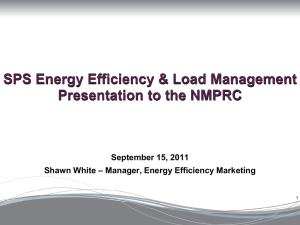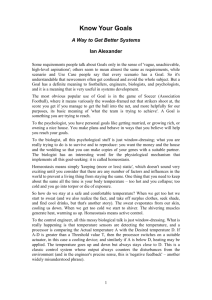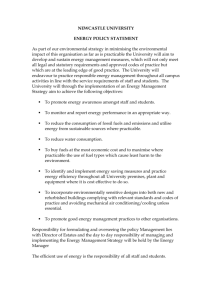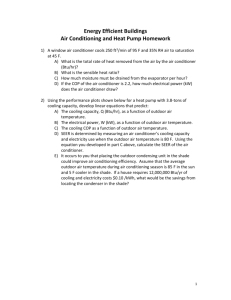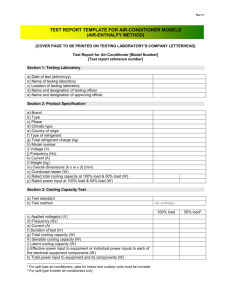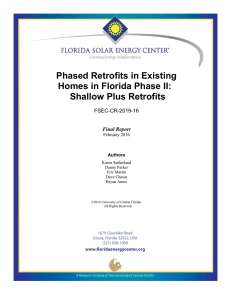presentation
advertisement
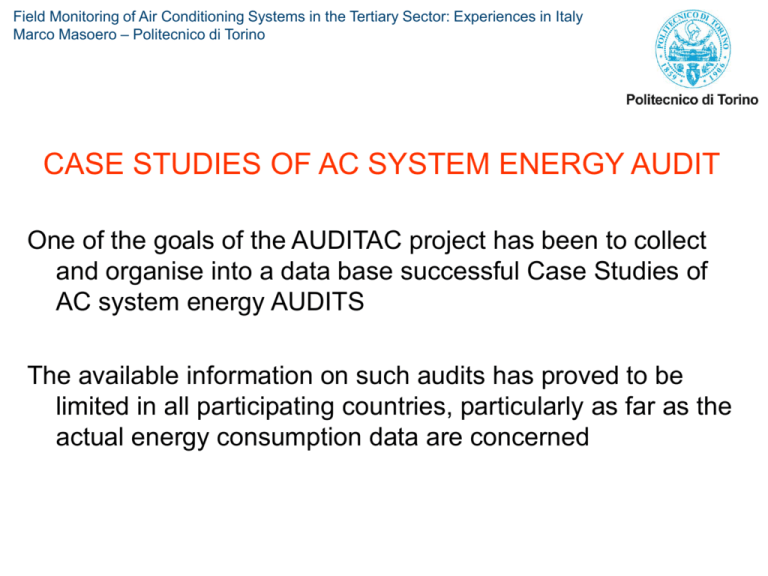
Field Monitoring of Air Conditioning Systems in the Tertiary Sector: Experiences in Italy Marco Masoero – Politecnico di Torino CASE STUDIES OF AC SYSTEM ENERGY AUDIT One of the goals of the AUDITAC project has been to collect and organise into a data base successful Case Studies of AC system energy AUDITS The available information on such audits has proved to be limited in all participating countries, particularly as far as the actual energy consumption data are concerned PROBLEMS ENCOUNTERED (1) The main energy input for AC systems is the electricity used by the motors that drive refrigerating compressors, fans, and pumps Generally, electrical energy is centrally metered at the grid interface (main delivery board) without separating the individual users (i.e., lighting, appliances, AC, etc.) Most energy service contracts include AC systems, but electricity bills are generally paid directly by the building owner / tenant Consequently, no real reasons exist at present for implementing a costly and relatively complex procedure of gathering disaggregated electricity use data PROBLEMS ENCOUNTERED (2) Most AC system retrofits carried out in the past (at least in Italy) were determined by reasons different from energy conservation, namely: • Improving the comfort condition in work spaces • Solving IAQ problems, or complying with compulsory regulations on air changes (e.g. in hospitals) • Replacing room air conditioners with a central HVAC system to overcome maintenance problems and to avoid excessive differences in indoor environmental conditions PROBLEMS ENCOUNTERED (3) For space heating, the Heating Degree-Day (HDD) method has been firmly established since decades as a simple and reliable means for correlating energy consumption and local climate Standard methods for AC energy data analysis are not as well known and established in the professional community CASE STUDIES FOR ITALY Three case studies are presented: 1. Hospital in NE Italy: air conditioning of a surgery / nursing department 2. Hospital in NW Italy: retrofits of existing refrigeration equipment 3. Water-to-water heat pump system for a small Auditorium CASE STUDY No. 1 Surgery / nursing department: •Air-conditioned floor area 350 m2 •Two identical AHUs each with: •9700 m3/h air supply (100% outdoor) •8800 m3/h extraction •Fan power: 11 kW supply, 4 kW extract •Intermediate-fluid heat recovery The energy analysis has been focused on optimising the operation of the Air Handling Units Monitoring campaign data (June-September 2006): •Electricity consumption of the heat recovery loop circulation pump •Air and water temperatures (16 sensors) Heat Recovery data analysis: •Measured average effectiveness of the existing recovery system: 58% (A) •Estimated effectiveness of an air-to-air recovery system: 65% (B) Heat recovery type Δ (B–A) A B Recovered thermal energy (kWh) 2955 7819 4864 Chiller electrical energy savings (kWh) 1477 3910 2433 Pump electrical consumption (kWh) 389 0 -389 Net electrical energy savings (kWh) 1088 3910 2822 •Seasonal savings with existing recovery system: 300 € (A) •Seasonal savings with air-to-air recovery system: 500 € (B) Free cooling with outdoor air: •Free cooling by direct supply of outdoor air (without mechanical cooling) is assumed feasible when Tout < 20°C •Estimated energy savings Free cooling Cooling energy (kWh) YES NO Δ Δ(%) 48075 57079 9004 16% Chiller electrical energy (kWh) 24037 28539 4502 16% CASE STUDY No. 2 Retrofits of existing refrigeration equipment : •No cooling foreseen at time of hospital construction (early 1960s) •15 chillers installed were needed •Retrofit work includes: •New water loop connecting the units •Two new chillers (963 kW cooling each) Several different strategies of refrigeration units management (including recovery of condensation heat) have been analysed Partial replacement of existing chillers with the new ones Euro/Day Daily cost for electric energy and possible saving in the analyzed period € 440 € 390 € 340 € 290 € 240 € 190 € 140 € 90 € 40 Obtained saving Old chillers os t Av era ge C Oc tob er Se pte mb er 16 -30 Se pte mb er 1-1 5 Au gu st 16 -30 Au gu st 1-1 5 Ju ly Ju ne Ma y Ap ri l -€ 10 New chillers Recovery of condensation heat for SHW production: Economic analysis (Net Present Value) NPV € 6.000 € 4.000 € 2.000 €0 -€ 2.000 -€ 4.000 -€ 6.000 -€ 8.000 -€ 10.000 -€ 12.000 -€ 14.000 -€ 16.000 0 1 2 3 4 5 6 Years CASE STUDY No. 3 Monitoring of a water-to water heat pump for a small Auditorium: •Air-conditioned floor area 300 m2 •Fan-coil + primary air (3200 m3/h) HVAC •Heat Pump cooling power 68 kW @ 7-12°C •Heat Pump heating power 60 kW @ 40-45°C •Heat source / sink: lake water Heat Pump / HVAC System Scheme AHU SECONDARY CIRCUIT FAN COIL PRIMARY CIRCUIT HEAT PUMP TO LAKE FROM LAKE BEMS Monthly average Heat Pump C.O.P. vs. outdoor temperature Monthly average C.O.P. 4,5 4,0 3,5 3,0 2,5 2,0 1,5 1,0 0,5 0,0 30 25 20 15 10 5 0 May June July C.O.P. August Outdoor temperature September [ °C ] Supplied energy Cooling energy vs. air temperature, air specific humidity and air enthalpy 190 Supplied energy [ kJ / m^3 ] 210 [ kJ / m^3] 190 170 150 130 170 150 130 110 110 90 90 20 21 22 23 24 25 26 27 28 29 30 7 9 11 13 15 Curva cumulativa del fattore di carico giornaliero Specific humidity [ kg H2O / kg AIR ] 0,0 0,1 Outdoor temperature [°C] Supplied energy 120 190 100 [ kJ / m^3 ] 170 80 150 [%] 60 130 40 110 20 90 0 35 40 45 50 55 Outdoor air enthalpy [kJ/Kg] 60 65 0,2 0,3 0,4 Utilization factor 0,5 0,6 0,7 Conclusions (1) The implementation of EPBD’s article 9 may offer a unique opportunity to promote effective energy savings policies in building air conditioning In order to transform this opportunity into a real market, several technical and institutional barriers still have to be overcome: • National legislations must provide clear guidance on AC inspection, in terms of timing, methodologies, reference standards, official inspecting bodies , etc. • Incentives should be adopted in order to promote energy service contracts including clauses that – similarly to what is already customary in space heating – remunerate electrical energy savings in summer air conditioning Conclusions (2) • Technical standards, accepted by the professional and scientific community, are needed both for the calculation of summer AC energy and for the evaluation of ECOs • Provisions for disaggregated electricity use metering should become customary in new installations and incentives for retrofitting the existing one should also be introduced To overcome these barriers, a concerted action will be necessary in the coming years involving, at the Community level, more EC funded research and CEN activities, and, at the National level, an effort to complete the implementation of the EPBD to include summer air conditioning.
